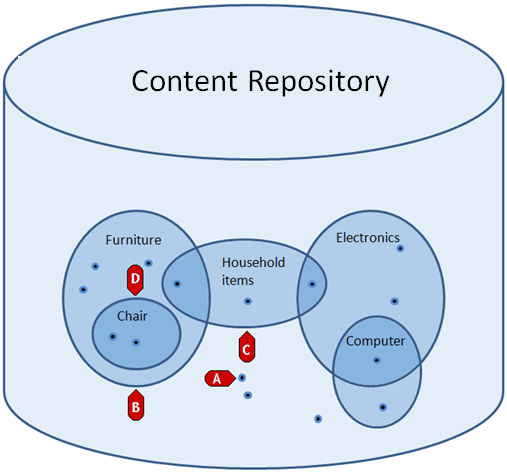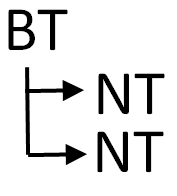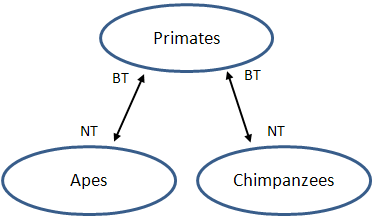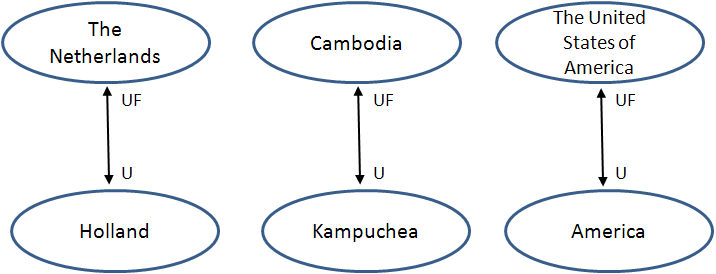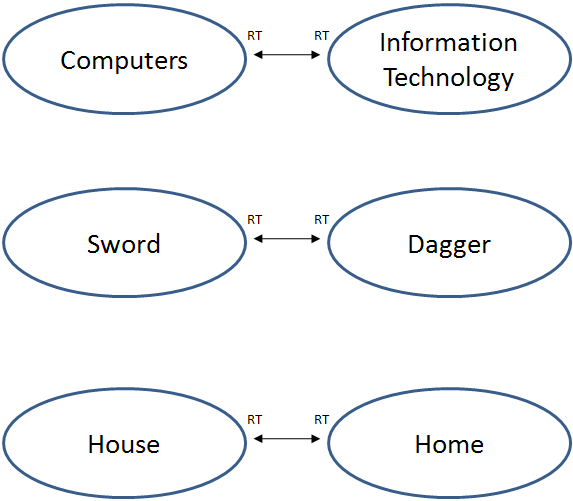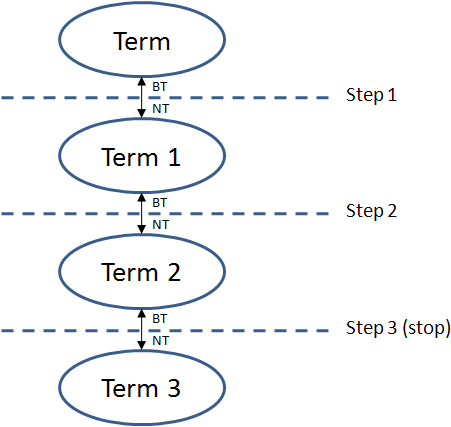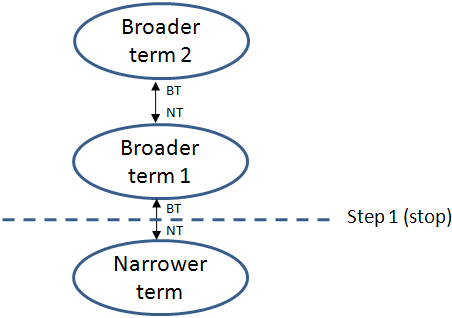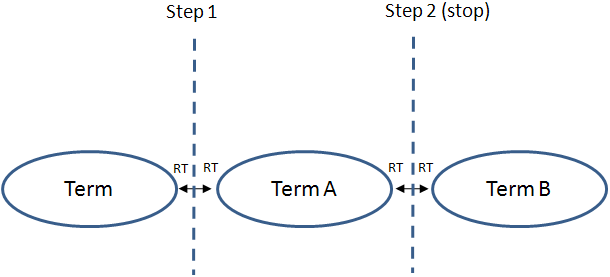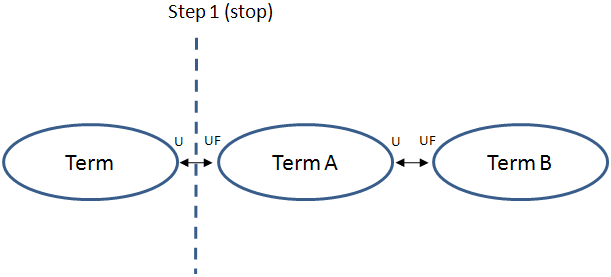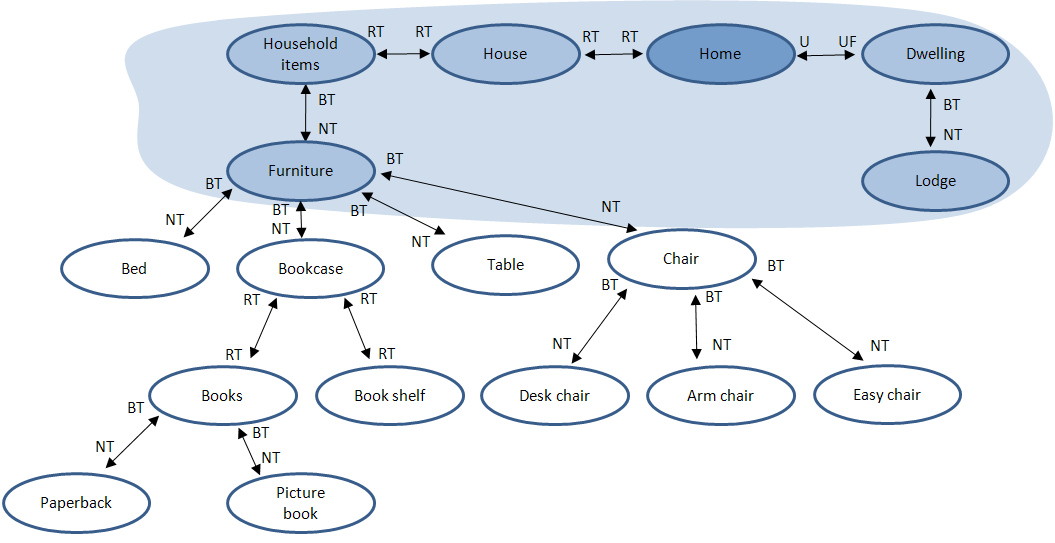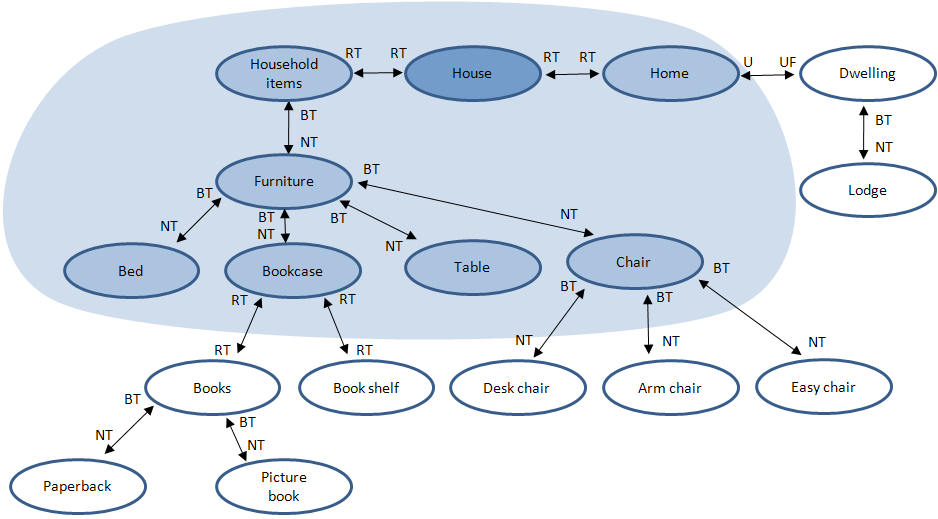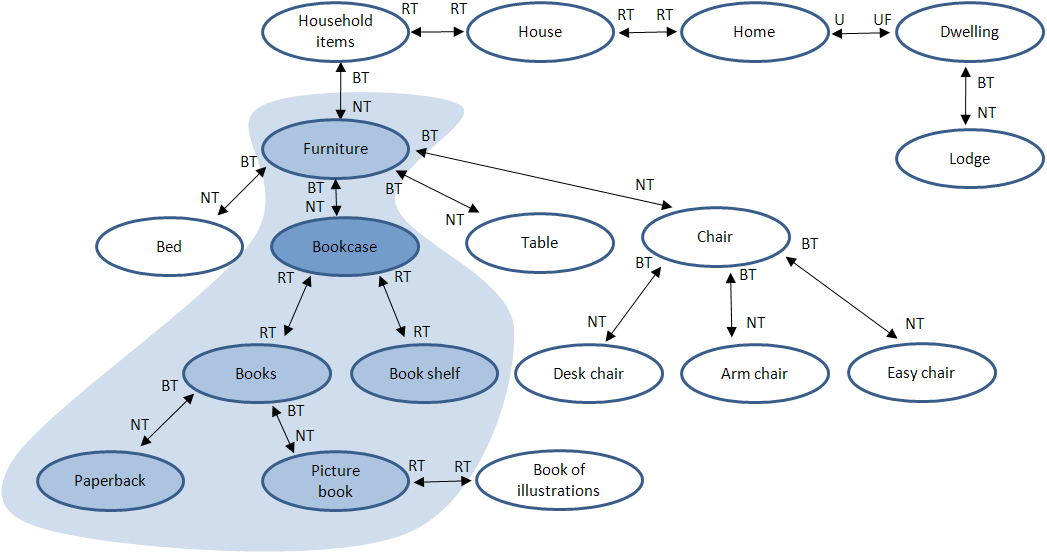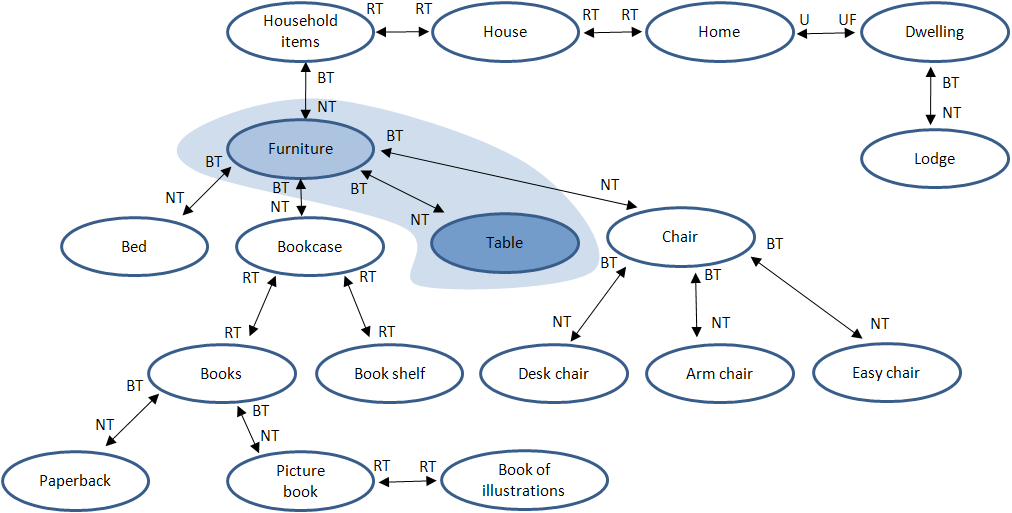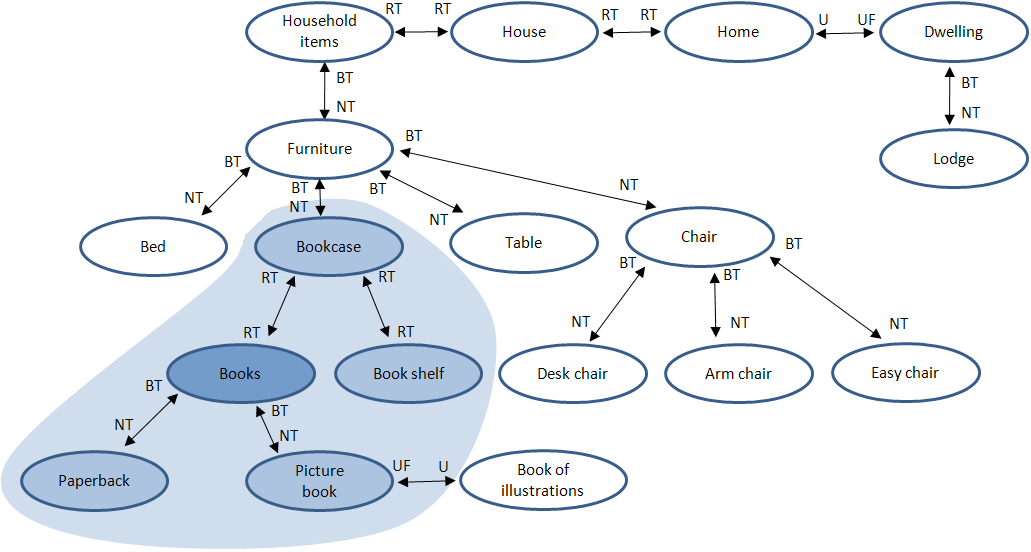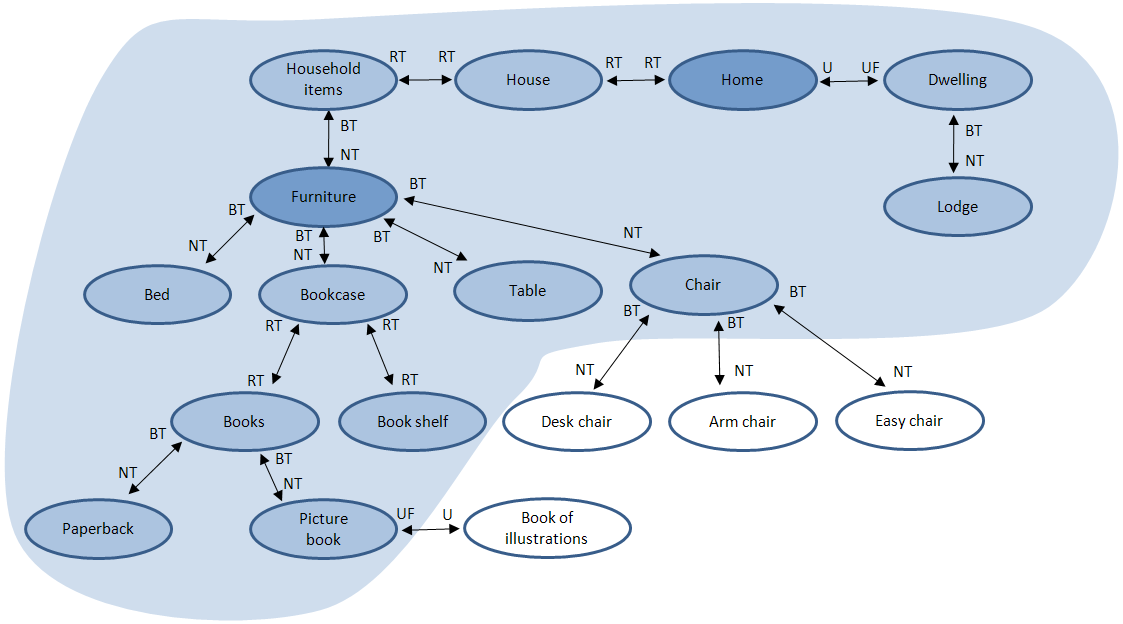In XperienCentral's Content Repository, you can assign tags (also referred to as "terms" in this topic) to content items. By assigning one or more tags to a content item, you can control when and how these content items are retrieved and displayed on your web site. In addition to assigning one or more tags to an object, you can create thesaurus relationships between tags in order to fine-tune the results returned by the Media Overview content element. Creating relationships between tags forms the basis of a thesaurus, which in its strictest sense is defined as "a categorized index of tags for use in information retrieval". Consider the following:
In the figure above, objects in the Content Repository are represented by the small circles. The shaded ovals represent tags (Furniture, Electronics, and so forth). The content items within the shaded ovals have that tag or tags assigned to them. The relationship between various content items/tags are as follows:
- An content item with no tags assigned to it (A).
- A tag assigned to six different Content Repository items (B).
- An item with one tag assigned to it and related to two others through a thesaurus relationship (C).
- Two items with four tags related to them through a thesaurus relationship (D).
When you specify a tag in a Media Overview element, the content items that are returned are directly affected by the thesaurus relationships between that tag (the source tag) and the tags it has a thesaurus relation with. From the example above, if you specify the term "Household items", three content itens will be returned. If you specify "Computer", two content items will be returned, and so forth.
In This Topic
Term Relationships
Thesaurus relationships between keyword terms are broken down into the following three categories:
| Relationship | Description |
|---|---|
Hierarchical | Hierarchical relationships are used to define broader and narrower scopes between tags. A broader tag is a wider generalization of a narrower tag, for example "vehicle" can be used to describe a "truck", "car", "motorcycle" and "bicycle". In this example, "vehicle" is the broader tag and "truck", "car", "motorcycle" and "bicycle" are narrow tags for "vehicle". Likewise, "compact", "sub-compact" and "sedan" are narrower tags for the broader tag "car". A broader/narrower tag relationship can also be referred to as a parent/child relationship. Child tags sharing the same parent are referred to as siblings. In XperienCentral, when you define a tag as being a broader or narrow tag for another, the reciprocal relationship is automatically created. For example if you assign "vehicle" as the broader tag for "car", "car" is automatically assigned as a narrower tag for "vehicle". In thesaurus nomenclature, broader tags are abbreviated as "BT" and narrower tags are abbreviated as "NT", for example: |
| Equivalency | Equivalency relationships are used primarily to tie synonyms and near-synonyms together. Oftentimes the equivalency relationship acts as a bridge or tie between an official or preferred tag and one or more unofficial or casual versions. For example the "United States of America" is the official name of the country but it is also commonly referred to as "The US" and "America". In XperienCentral's thesaurus nomenclature, equivalency relationships are tied together using "Use for" (U) and "Is used for" (UF) indicators. "Use for" and "Is used for" tags always have a reciprocal relationship. For example, if "The United of America" has an "Is used for" relationship with "America" then "America" automatically has a "Use for" relationship with "The United States of America". |
| Associative | Associative relationships are used in cases where the relationship between the tags is neither of the above types. For example, "Information technology" is related to "computers" in the sense that information technology is managed and made possible by computers but the relationship is neither hierarchical nor equivalent. In XperienCentral's thesaurus nomenclature, associative relationships are referred to using the "related to" (RT) indicator. |
Broader/Narrower Tag Relationships
Broader and narrower tag relationships are used to establish parent/child relationships between tags in a hierarchy. For example, in the following simple hierarchy containing three tags, "Primates" is the broader tag (parent) of "Apes" and "Chimpanzees":
You use broader/narrower tags to create tag hierarchies. In this example, "Primates" is defined as a broader tag for "Apes" and "Chimpanzees" and conversely, "Apes" and "Chimpanzees" as narrower tags for "Primates". Symbolically the relationship can be conveyed as in the figure below where the abbreviation "BT" stands for broader tag and "NT" for narrower tag:
When you add a broader or narrower tag relationship, the reciprocal relationship is also created at the same time. For example, adding "Apes" as a narrower tag for "Primates" also adds "Primates" as a broader tag for "Apes".
Use for/Is Used for Relationships
Use for/Is used for tag relationships allow you to create a relationship between two or more tags that denote the same thing when one of them is the more common or preferred tag for the entity in question. "Is used for" and "Use for" tags are always reciprocal. This relationship is used in a variety of situations, such as when you want to tie tags together with synonyms or near synonyms of the tag. Consider the following place names:
- Holland/The Netherlands
- Kampuchea/Cambodia
- America/The United States of America
The first name listed in each line does identify the country in question, but it is less precise than the second name listed. For historical reasons, the country "The Netherlands" has been also identified by the name of "Holland" and it is a meaningful substitute, however it is not the preferred tag. In such cases it is useful to create a "Use for/Is used for" relationship between these two names in order to ensure that any reference to "Holland" also points to objects identified with the preferred tag "The Netherlands". In the example below, the "Use for/Is used for" relationships between tags can be conveyed as follows. In the figure, "UF" stands for "Is used for" and "U" stands for "Use for":
Thus, any tag that references or that have a thesaurus relationship with "Holland" will also lead to tags that have a thesaurus relationship with "The Netherlands".
The meaning of "User for" and "Is used for" in the context of the current tag can be a little confusing. When a tag has a "Use for" tag assigned to it, you should read the relationship as "Use for the current tag the tag X". For example, if the tag "America" has a "Use for" relationship with the tag "The United States of America", read it as "Use for America the tag The United States of America". When a tag has an "Is used for" tag assigned to it, you should read the relationship as "The 'Is used for' tag is used for the current tag". Thus, if the tag "America" has an "Is used for" relationship with the tag "The United States of America", read it as "The United States of America is used for America".
Related Tag Relationships
Related tag relationships (RT) are used primarily for tags that have neither a hierarchical nor equivalent relationship. Related tags have an associative relationship and bear a close conceptual relationship with the main tag. You can also think of the "RT" relationship as a "See also" reference.
For example:
Tag Depth
How tags are related to each other in the thesaurus has a direct effect on the number of objects that are retrieved from the Content Repository when a tag is referenced in a Content Overview or Dynamic Content Overview content element. This is because for each thesaurus relationship that a tag has, it automatically has relationships with other tags through their defined relationships. For each thesaurus relation type in XperienCentral, rules are applied to detagine what the wider context of thesaurus relations is as a result of the stepping that is performed from one tag to another. The stepping between relationships detagines what a tag's wider thesaurus context is. For each thesaurus relationship type, a predefined number steps between tags is followed from a source tag. The number of steps (tag depth) that is followed for each thesaurus tag relationship in XperienCentral is:
| Relationship | Depth |
|---|---|
| Broader tag (BT) | 1 step |
| Narrower tag (NT) | 3 steps |
| Related to (RT) | 2 steps |
| Use for (U) | 1 step |
| Is used for (UF) | 1 step |
The implications of the stepping rules are described for each of the thesaurus relationships below.
The tag depth rules shown above are the default values in XperienCentral. It is possible, however, for these values to be modified for your project. In this case, the examples given in this topic do not apply to you and your results will be different.
- Application Managers: If you modify the depth rules, notify your Main Editor(s) and Editor(s) so that they can determine what the implications for thesaurus relations are with regard to their content.
- Main Editor(s) and Editor(s): If the content that is returned by the Content Repository given the thesaurus relations you have defined deviates from what is described in this topic, contact your Application Manager and ask whether the default rules have been modified for your project;
Narrower Tag Relationship
From a source tag, XperienCentral will follow a chain of three steps through successive NT relationships and then stop. In the following example, if the source tag is "tag", it will have a thesaurus relationship with "tag 1", "tag 2", and "tag 3". The relation between "tag" and "tag 1" is a direct relationship, that is, they are tied directly together through a "Broader/Narrower tag" (BT/NT) relationship. The relationship between "tag" and "tag 2" and "tag" and "tag 3" is indirect, as is that between "tag1" and "tag 3":
Broader Tag Relationship
From a source tag, XperienCentral will step to a broader tag and stop. A step from a narrower tag to a broader can only happen in the context of a direct relationship between the two. From the stepped-to tag (the broader tag), no other broader tags will be stepped to. For example, if "Narrower tag" is the source tag, "Broader tag 1" is considered a relation but "Broader tag 2" is not:
Related to
For tags that are related to each other, XperienCentral will follow a chain of two successive "related to" steps to other tags from the source tag and then stop. In the following example, if "tag" is the source tag, it has a direct relationship with "tag A" and an indirect relationship with "tag B":
Use for/Is used for
For "Use for" and "Is used for" relationships, XperienCentral will step from the source tag to the "Use for" or from the source to the "Is used for" tag and then stop. A tag must have the relationship "Use for" or "Is used for" directly with the source tag, that is, it cannot be reached through an indirect relationship. Once a "Use for" or "Is used for" step is completed, no further "Use for" or "Is used for" relations can be made. In the example below, "tag" has a direct relationship with "tag A" but not with "tag B" and vice versa.
Multiple Relationship Depths
The examples above describe simple situations where all the relationships are the same, for example from a broader tag to a narrower tag that is itself a broader tag for a subsequent narrower tag ,and so forth, to a depth of three (BT > NT > NT > NT). In reality, thesaurus relations consist of complicated combinations of relationship types (BT/NT, U/UF, and RT). How tags are related to each other through combinations of the relationship types has a direct effect on the outcome of the broader context thesaurus relationships a tag has. This section describes how the stepping process in complex thesaurus relationships works.
The overall number of steps that XperienCentral will follow from a source tag to the other tags it is tied to through thesaurus relationships is 3. This means that the depth rule for each of the relationship types is affected by the number of steps that precede it as well as the type of relationship that results in a tag being stepped to. The table below describes how each successive step affects the depth to which each of the thesaurus relationship types is followed.
| Relationship | Steps available from source | Depth after 1 step | Depth after 2 steps | Depth after 3 steps |
|---|---|---|---|---|
| Broader tag (BT) | 1 | 0 | 0 | 0 |
| Narrower tag (NT) | 3 | 2 or 0 (When a source tag steps to a broader tag, the number of available NT steps for the broader tag becomes 0 because a broader/narrower tag pairing is a parent/child relationship. This prevents the siblings of the child (narrower/source) tag from being selected because they are not logically related.) | 1 | 0 |
| Related to (RT) | 2 | 1 | 0 | 0 |
| Use for (U) | 1 | 0 | 0 | 0 |
| Is used for (UF) | 1 | 0 | 0 | 0 |
For example, given the rules set forth in the table above, if you step from a source tag to a tag tied to it through a "related to" relation (RT) and that tag has three levels of narrower tags under it, XperienCentral will only step to two of the three levels of narrower tags. This is because the NT depth rule after step 1 is 2.
In order to illustrate the depth rules, the following six examples show how thesaurus relationships and depth rules detagine which tags will be detagined to have a broader context relationship with a source tag and thus which content items will be returned by a Content Overview or Dynamic Content overview content element containing the source tag(s). In the examples below, the following colors/acronyms are used:
Tag Depth Example 1
| Tags related to source tag | Description |
|---|---|
| Home | Source tag. Available steps from Home: UF/U = 1 RT = 2 BT = 1 NT = 3 |
| Dwelling | 1 UF step from Home. Available steps from Dwelling: UF/U = 0 RT = 1 BT = 0 NT = 2 |
| Lodge | 1 UF step from Home. Available steps from Lodge: UF/U = 0 RT = 0 BT = 0 |
| House | One RT step from Home. Available steps from House UF/U = 0 RT = 1 BT = 0 NT = 2 |
| Household items | 1 RT step from House. Available steps from Household items: UF/U = 0 RT = 0 BT = 0 NT =1 |
| Furniture | 1 NT step from Household items. Available steps from Furniture: None. |
Tag Depth Example 2
| Tags related to source tag | Description |
|---|---|
| House | Source tag. Available steps from House: UF/U = 1 RT = 2 BT = 1 NT = 3 |
| Home, Household items | 1 RT step from House. Available steps from Home and Household items: UF/U = 0 RT = 1 BT = 0 NT = 2 |
| Furniture | 1 NT step from House. Available steps from Furniture: UF/U = 0 RT = 0 BT = 0 NT =1 |
| Bed, Bookcase, Table, Chair | 1 NT step from Furniture. Available steps from Bed, Bookcase, Table, and Chair: None. |
Tag Depth Example 3
| Tags related to source tag | Description |
|---|---|
| Bookcase | Source tag. Available steps from Bookcase: UF/U = 1 RT = 2 BT = 1 NT = 3 |
| Furniture | 1 BT step from Bookcase. Available steps from Furniture: The number of NT steps for Furniture becomes 0 because the sibling tags Bed, Table, and Chair are not logically related to Bookcase. |
| Books, Book shelf | 1 1 RT step from Bookcase. Available steps from Book shelf: UF/U = 0 RT = 0 BT = 0 NT =1 |
| Paperback, picture book | 1 NT step from Books. Available steps from Paperback and Picture book: None. |
Tag Depth Example 4
| Tags related to source tag | Description |
|---|---|
| Table | Source tag. Available steps from Table: UF/U = 1 RT = 2 BT = 1 NT = 3 |
| Furniture | 1 BT step from Table. Available steps from Furniture: The number of NT steps for Furniture becomes 0 because the sibling tags Bed, Bookcase, and Chair are not logically related to Table. |
Tag Depth Example 5
| Tags related to source tag | Description |
|---|---|
| Books | Source tag. Available steps from Books: UF/U = 1 RT = 2 BT = 1 NT = 3 |
| Bookcase | 1 RT step from Books. Available steps from Bookcase: UF/U = 0 RT = 1 BT = 0 NT = 2 |
| Book shelf | 1 1 RT step from Bookcase. Available steps from Book shelf: There is one NT depth left to step, however, since Book shelf has no NT relations, stepping stops. |
| Paperback, picture book | 1 NT step from Books. Available steps from Paperback and Picture book There are two NT depths left to step, however, since these two tags have no NT relations, stepping stops. |
Tag Depth Example 6
| Tags related to source tag | Description |
|---|---|
| Home | Source tag. Available steps from Home: UF/U = 1 RT = 2 BT = 1 NT = 3 |
| Dwelling | 1 UF/U step from Home. Available steps from Dwelling: UF/U = 0 RT = 1 BT = 0 NT = 2 |
| Lodge | 1 NT step from Dwelling. Available steps from Lodger: UF/U = 0 RT = 1 BT = 0 NT = 1 |
| House | 1 RT step from Home. Available steps from House UF/U = 0 RT = 1 BT = 0 NT = 2 |
| Household items | 1 RT step from House. Available steps from Household items UF/U = 0 RT = 0 BT = 0 NT =1 |
| Furniture | Source tag. Available steps from Furniture: UF/U = 1 RT = 2 BT = 1 NT = 3 |
| Bed, Bookcase, Table, Chair | 1 NT step from Furniture. Available steps from Bed, Bookcase, Table, and Chair UF/U = 0 RT = 1 BT = 0 NT = 2 |
| Books, book shelf | 1 RT step from Bookcase. Available steps from Books and Book shelf UF/U = 0 RT = 0 BT = 0 NT = 1 |
| Paperback, Picture book | 1 NT step from Books. Available steps from Paperback and Picture book None |
Content Repository Article Example
This section provides a practical example of how thesaurus relationships affect how articles are returned by Content Overview and Dynamic Content Overview elements. The following articles have been added to the Content Repository and they have the following tags assigned to them:
| Article | Assigned tag(s) |
|---|---|
| New clue to the cause of muscular dystrophy uncovered | Science |
| Hubble telescope repairs delayed | Science |
| iPhone 8 now available | Technology |
| YouTube announces mobile device support | Technology |
| Coen brothers win best picture honors | Movies |
| David Geffen leaves DreamWorks | Movies |
| US entertainment industry considers tightening ratings | Entertainment |
| London Philharmonic hires new music director | Music |
| Beckham signs with AC Milan | Sports |
| Benelux countries hope to host 2018 World Cup | Sports |
The following thesaurus relationships have been created between the following tags:
| Tag | RT | BT | NT | UF | U |
|---|---|---|---|---|---|
| Science | Technology | ||||
| Technology | Science | Tech | |||
| Movies | Entertainment | ||||
| Entertainment | Movies, Music, Sports | ||||
| Music | Entertainment | ||||
| Sports | Entertainment | ||||
| Tech | Technology |
Article example 1
Based on the table above, the following articles are shown when a Content Overview element is placed on a page based on the keyword "Tech":
- YouTube announces mobile device support
- iPhone 8 now available
- New clue to the cause of muscular dystrophy uncovered
- Hubble telescope repairs delayed
Article Example 2
Based on the table above, the following articles are shown when a Content Overview element is placed on a page based on the keyword "Entertainment":
- Benelux countries hope to host 2018 World Cup
- Beckham signs with AC Milan
- London Philharmonic signs new music director
- US entertainment industry considers tightening ratings
- Coen Brothers win best picture Oscar
- David Geffen leaves DreamWorks
